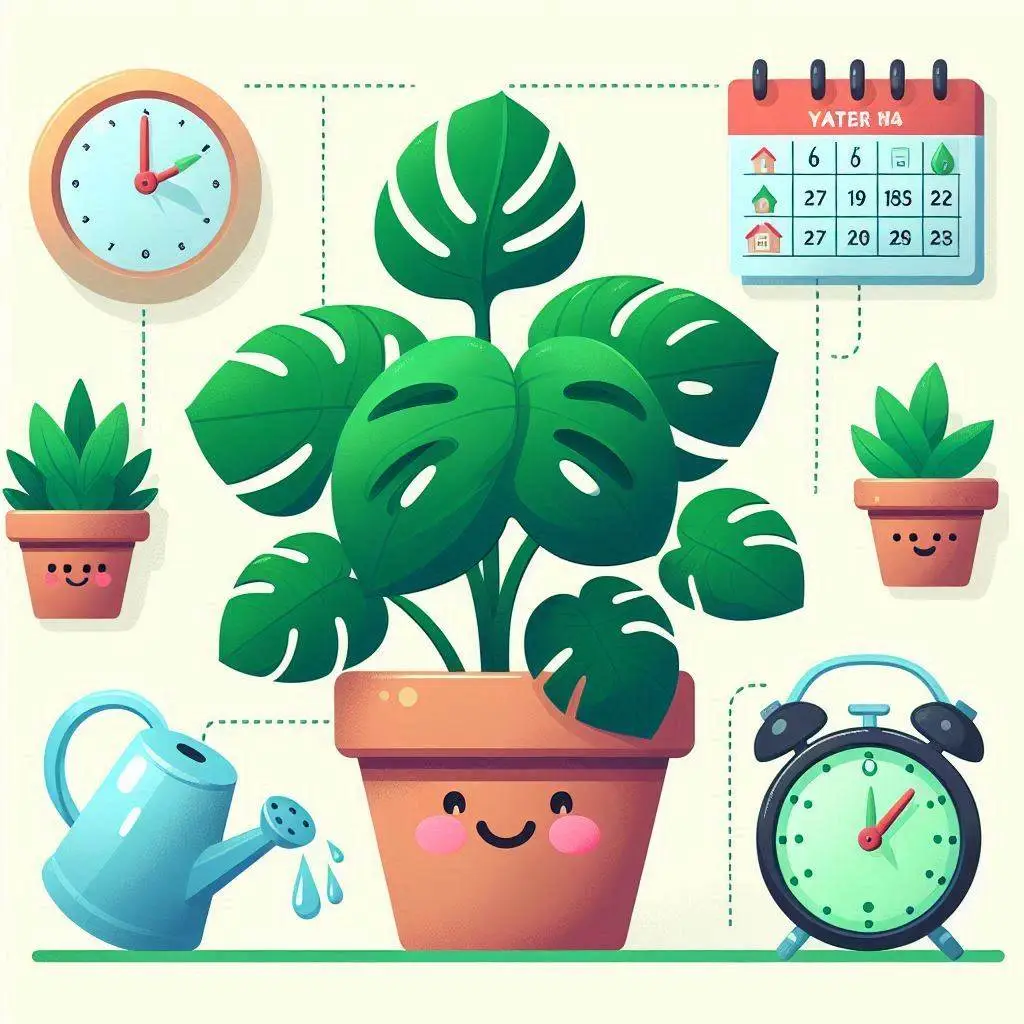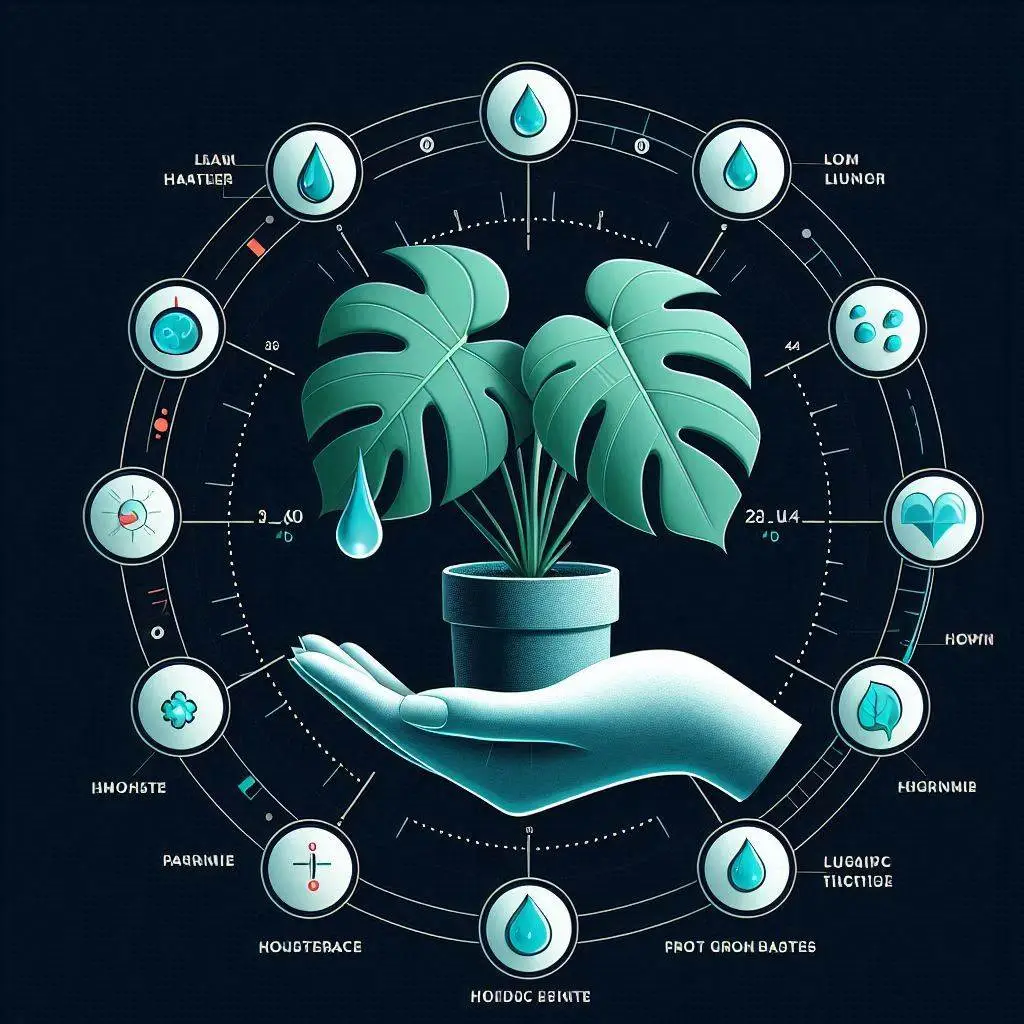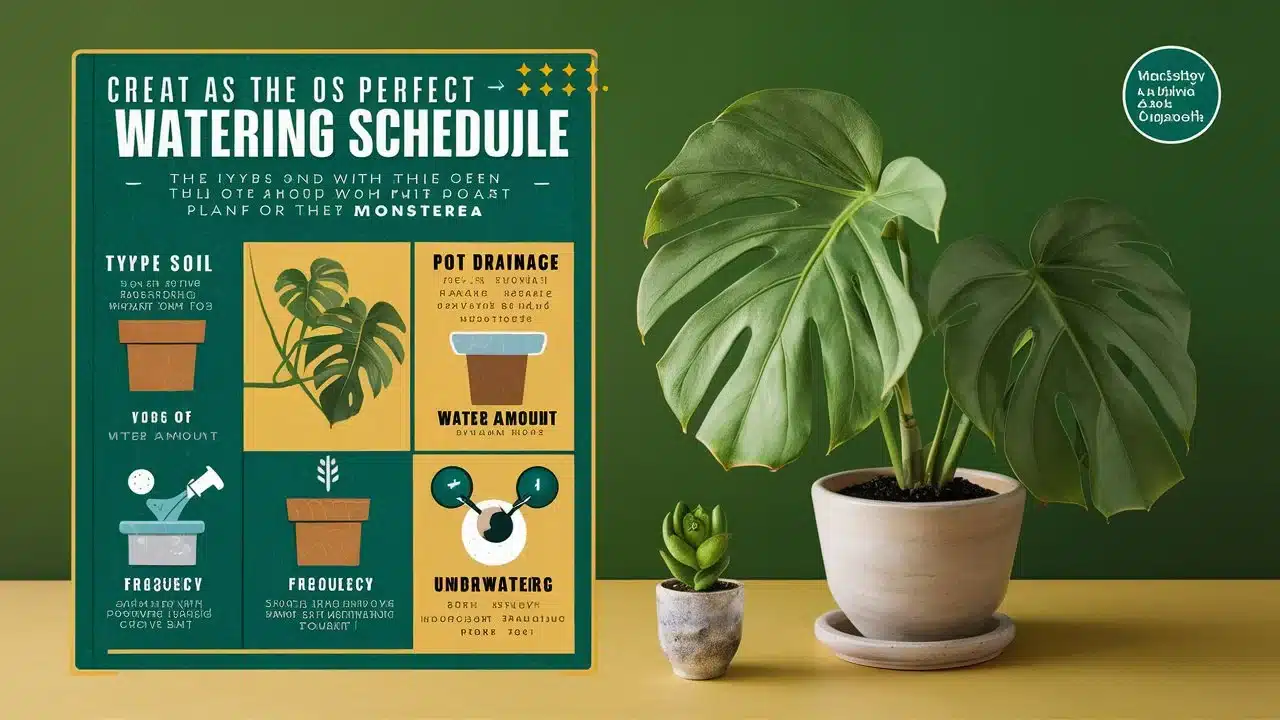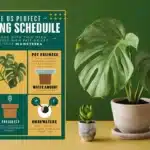Creating the perfect watering schedule for your Monstera plant can be the difference between vibrant, thriving growth and a struggling, unhappy plant.
In this comprehensive guide, we’ll walk you through all the essential steps to maintain your Monstera’s health through an optimized watering routine.
From understanding its natural habitat to spotting signs of overwatering and underwatering, we’ll cover everything you need to know to keep your Monstera healthy.
Why a Watering Schedule Matters for Your Monstera

A well-thought-out watering schedule is crucial to maintaining the health of your Monstera. Without a consistent routine, you might end up with issues like root rot, yellowing leaves, or poor growth. Since Monstera plants hail from tropical rainforests, their watering needs are specific and vary depending on environmental factors such as humidity, light exposure, and the seasons.
Mistakes like overwatering or underwatering are common with houseplants, and a solid watering schedule will help avoid these pitfalls. Understanding your plant’s specific hydration requirements allows you to create a thriving environment for your Monstera—whether it’s the towering Monstera deliciosa or the smaller Monstera adansonii.
Understanding Monstera’s Natural Watering Needs
Monstera’s Origin and Habitat
The Monstera plant is native to the tropical rainforests of Central and South America, where they grow under the canopy of large trees. In this environment, they are exposed to frequent but indirect water from rainfall and high humidity.
These plants have adapted to environments where water drains quickly through well-aerated soil, allowing roots to breathe. The key takeaway? Monsteras prefer being in soil that is moist but never soggy.
Watering Frequency in the Wild
In the wild, Monstera plants go through alternating periods of wet and dry conditions, which allows their roots to absorb water and then dry out in between. The perfect watering schedule for your Monstera should mimic this natural cycle, where the plant’s soil is allowed to dry partially before it’s watered again.
Key Indicators of a Healthy, Well-Watered Monstera

Understanding the visible signs of a well-watered Monstera can help you adjust your watering schedule over time. Here are some key indicators to look for:
Signs of Proper Hydration
- Firm, glossy leaves: Properly watered Monsteras have strong, vibrant leaves that aren’t droopy or wilted.
- Steady new growth: Healthy Monsteras consistently produce new leaves, especially during the growing season (spring and summer).
- Vivid green color: Well-hydrated Monsteras have a rich green color that signals they’re thriving.
Signs of Underwatering
Underwatering can stress your Monstera and lead to symptoms like:
- Curling or crispy leaves: If the edges of the leaves become brown and crisp, it’s a sign your plant is not getting enough water.
- Slow or stunted growth: Your Monstera will grow slower than usual if it doesn’t receive enough moisture.
- Dry soil: If the soil feels dry to the touch several inches down, your plant is due for watering.
Signs of Overwatering
Overwatering can lead to root rot, which is a common killer of houseplants. Signs of overwatering include:
- Yellowing leaves: One of the first signs of too much water is yellowing leaves, especially on the lower parts of the plant.
- Soggy or foul-smelling soil: If the soil stays wet for too long, it can smell musty or develop mold.
- Droopy leaves despite wet soil: This indicates waterlogged roots, which aren’t able to absorb oxygen.
Factors Influencing Your Monstera’s Watering Frequency

Several key factors influence how often you should water your Monstera, and these factors change based on your plant’s environment, its growth stage, and even the type of pot you use.
Environmental Conditions
Monstera plants thrive in humid, tropical environments, and indoor settings can often create challenges to replicate this. Here’s how you can adjust watering based on various conditions:
- Temperature: Warmer temperatures speed up soil drying, requiring more frequent watering.
- Humidity: Higher humidity levels help the plant retain moisture longer, reducing watering needs. In dry climates or winter heating, more frequent watering may be necessary.
- Light Exposure: A Monstera placed in bright, indirect light will use more water than one sitting in low light. Adjust accordingly.
Pot Size and Type
- Pot size: Larger pots retain more moisture, which means you’ll water less frequently compared to smaller pots, where the soil dries out faster.
- Pot material: Terracotta pots are porous and allow moisture to evaporate faster, while plastic pots retain water for longer.
Soil Type
Well-draining soil is critical for Monsteras. A mix containing peat, perlite, and orchid bark is ideal for ensuring good drainage and preventing waterlogged roots. Check the moisture level in the soil regularly to adjust watering.
Growth Stage of Your Monstera
- Young plants: These may need more frequent watering, especially as they establish roots.
- Mature plants: Established Monstera plants have larger root systems and can retain moisture for longer periods, requiring less frequent watering.
Creating a Watering Schedule: Step-by-Step Guide
Now that you understand the factors that influence watering, let’s create the perfect watering schedule for your Monstera.
Checking Soil Moisture Levels
The best way to determine when to water your Monstera is by checking the soil’s moisture level. Here are three common methods:
- Finger test: Stick your finger about 2-3 inches into the soil. If it feels dry, it’s time to water.
- Moisture meter: This tool provides a more accurate reading of how much water is left in the soil.
- Wooden stick method: Insert a wooden stick or skewer into the soil. If it comes out dry or nearly clean, your plant is ready for watering.
Frequency Based on Observation
- Spring/Summer: Water your Monstera every 7-10 days during the growing season.
- Fall/Winter: Water less frequently, about every 2-3 weeks, as the plant enters a more dormant phase.
Always adjust your schedule based on the environment and plant signals.
Watering Techniques for Monstera
- Deep watering: Ensure that water reaches all parts of the root system by watering deeply. Let water drain out of the bottom of the pot and avoid letting the plant sit in water.
- Bottom watering: Place the pot in a shallow tray of water and allow the roots to soak up moisture. This prevents overwatering the top layers of soil.
How to Water Properly
- Water until you see it draining from the bottom of the pot.
- Use room-temperature water to avoid shocking the plant’s roots.
- Avoid watering the leaves directly, as this can promote fungal growth.
Best Practices for Watering Your Monstera
- Water your plant in the morning to allow any excess water to evaporate during the day.
- Rotate your plant regularly to ensure even growth and water distribution.
Seasonal Adjustments to Your Monstera’s Watering Schedule
Monstera plants require different watering frequencies depending on the season.
Watering in Spring/Summer
During the growing season, your Monstera will use more water. Expect to water more frequently—every 7-10 days, depending on your environment. You’ll notice the plant is growing more leaves and producing more aerial roots, a sign that it’s thriving and needs more moisture.
Watering in Fall/Winter
As temperatures drop, Monsteras enter a semi-dormant state, where growth slows down. Cut back on watering to every 2-3 weeks. You might also need to adjust for lower humidity levels caused by indoor heating, which can dry out the air and the soil.
Signs of Seasonal Change Impacting Water Needs
- Increased humidity in spring and summer often means you can stretch out watering intervals.
- Dry indoor heating in winter may require more frequent misting or using a humidifier.
Advanced Watering Tips for Optimal Growth
For more experienced Monstera growers, here are some advanced watering techniques to ensure your plant thrives.
Humidity Control
Monstera plants love humidity, so increasing the moisture in the air can support overall growth. Here are ways to manage humidity:
- Misting: Light misting helps keep leaves moist but avoid overdoing it, as it can lead to fungal issues.
- Humidifiers: A room humidifier can help maintain 60-70% humidity levels, ideal for tropical plants like Monstera.
- Pebble trays: Place your Monstera on a tray filled with water and pebbles to create a more humid microenvironment.
Water Quality
Monstera plants can be sensitive to tap water that contains chlorine or hard minerals. Filtered or distilled water is preferable for long-term plant health.
Fertilizing During Watering
You can combine watering with fertilizing to boost your Monstera’s growth:
- Liquid fertilizer: Dilute liquid fertilizer into your watering routine every 2-4 weeks during the growing season.
- Slow-release pellets: Add slow-release fertilizer to your soil mix for consistent feeding over several months.
Watering During Repotting
When repotting your Monstera, water it lightly afterward to help the roots settle into the new soil. Avoid overwatering, as freshly repotted plants are sensitive to excess moisture.
Monitoring Root Health
Regularly check your Monstera’s roots to ensure they aren’t suffocating or rotting from too much water. Healthy roots should be white or light brown, not black or mushy.
Troubleshooting Common Watering Issues
Even with a well-established watering schedule, issues can arise. Here’s how to address some common problems:
What to Do if You’ve Overwatered
If you’ve accidentally overwatered your Monstera:
- Stop watering immediately. Allow the soil to dry out completely before watering again.
- Improve drainage: Check the pot for proper drainage holes or consider repotting into a better-draining soil mix.
- Remove affected leaves: Trim away yellow or wilting leaves to prevent the spread of rot.
How to Save an Underwatered Monstera
If your Monstera is showing signs of underwatering:
- Slowly rehydrate the plant by watering in small amounts over the course of a day.
- Soak the pot in water for 20-30 minutes, allowing the roots to absorb moisture.
Adjusting the Watering Schedule for Specific Monstera Species
Different Monstera species may have unique water requirements:
- Monstera adansonii tends to need more frequent watering than Monstera deliciosa due to its smaller size and quicker drying soil.
- For larger Monsteras, watering less frequently but more deeply is recommended.
Conclusion: Maintaining a Balanced Watering Routine
Creating the perfect watering schedule for your Monstera is all about consistency and observation. Each plant is unique and will signal its needs based on environmental factors and your care habits. By understanding the plant’s natural water cycle, using proper watering techniques, and adjusting for seasonal changes, you can ensure your Monstera thrives year-round.
A well-hydrated Monstera rewards you with lush, dramatic foliage—so take the time to perfect your watering routine, and enjoy the beautiful results!
This article has provided a detailed guide on how to create the perfect watering schedule for your Monstera. By incorporating practical tips, case studies, and advanced watering techniques, you’re now equipped to keep your plant thriving.









